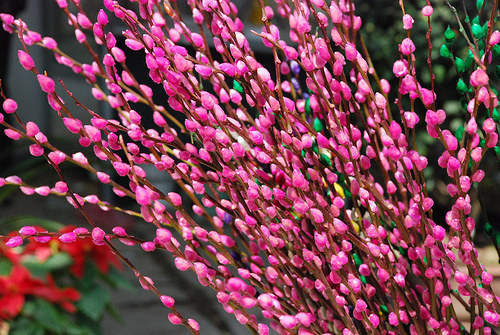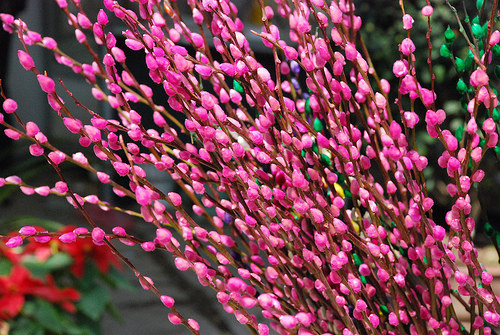
Ha Minh Duc's poetry focuses on ideas, which is the way for the poet to push emotions into depth, creating impressions and obsessions. Reading his poetry, we often have to ignore the rhythm of the language form to listen to the melodies inside the soul and feelings. In other words, Ha Minh Duc's poetry has a distillation of direct vibrations and a deep stream of thoughts. Thanks to that, the intellectual beauty and generalization of the poem are displayed and enhanced. Possessing a poetic mindset rich in inner strength, combined with profound experiences of life, the author can both discover the unique and very own signs of a flower that takes "floating" as a fulcrum, and portray the portrait of a person who has found the meaning of his existence in the vast world:

There is a flower vine halfway up
Follow the wall forward
Green leaves like bewilderment
Where to go?
The sky is high above
Let the wind sway
The support is the support
Cherish the little flower every day
Bring joy to people
(Climbing flowers)
It is not by chance that at first the author intended to name the work "Flowers in the Rainy Afternoon", or: "Flowers in the Rainy Afternoon", and later changed it toSpring remembers the sun– a more evocative and “sparkling” name… But whatever the name, it seemsFlowerstill the main character, given the "right to speak" by the author...
Flowers in Ha Minh Duc's poetry are delicately perceived in both color and scent. Depending on the inner development, the author will choose the space where the flowers exist, whether sunny or rainy, and the time, whether morning or afternoon, day or night. The technique of contrast and opposition is exploited to create aesthetic effects:
No more sunshine
For bright flower color
No more wind
Let the fragrance of flowers spread
The petals glisten with morning dew
And whose hand?
Cosset
But the rain suddenly came
The sun gradually sets and the sky is filled with mist and rain.
Why are you still standing here?
Mourning every falling petal
The flowers were suddenly tattered
(Flowers in the rainy afternoon)
A day from dawn to dusk is the time for flowers to bloom and spread their fragrance. When night falls, it is also the time to close a flower's life. But the day may not have ended yet, but the flower has already withered. From those direct descriptions, the author ended the poem with a personification:
Tomorrow will be bright again
The rains come again
I secretly worry about fate
A day like a flower's life
(Flowers in the rainy afternoon)
Repeating in Ha Minh Duc's poetry are images of flowers past their prime, like the fate of women entering their twilight years - "the end of their beauty season". The sadness and regret of a "glorious time" that cannot be held back, as a matter of course, has become a stream of memories tinged with sorrow:
I still remember
Dawn flowers bloom
The afternoon has faded
My life is like a flower
There are bright days
Beauty reigns supreme
The girl with a lot of power…
(Flowers fade)
From the lyrical subject’s perspective, through the “hidden dialogue”, the poet – the author – also shares similar feelings. Indeed, in life past and present, at any time and place, beauty has its own power. The sad thing is that many times, the other half of the world feels and understands more not only the value and strength but also the fragility of that “one-day” power:
Why not like flower life?
In the midst of decline
The scent of flowers rises to the sky
Thousands of petals follow the wind…
Just leave in this world
Unending love
(Flowers fade)
The story of “pitying flowers and regretting jade” has always been very familiar in the system of metaphors in poetic art in general and especially in the traditional poetics of the East and national poetry in particular: from folk (folk songs) to classical and modern. Through the combined image: flower fate - human life, the poet will send and entrust his life philosophy and humanistic thoughts. Some poems such asVine flowers, Flowers in the rainy afternoon, Faded flowers…written in that "aesthetic" spirit. However,Spring remembers the sunThe strong impression is also created by the presence of a world of female lyrical characters, including “strange flowers”: Ba Chua Kho, Thi No… And flowers at this time no longer have a general symbolic meaning but are the individual faces of each fate. In Ha Minh Duc’s poetry, there is a “Queen of Nom poetry” who is more talented than others but whose name is still a mystery to this day - poetess Ho Xuan Huong:
The talented girl
A pure and loyal heart
A lifetime can teach you endless words.
Maybe spring is fading
Flowers are buried in the green grass
(Ho Xuan Huong)
Thuy Kieu, "whose beauty she demands first, her talent she demands second," had many ups and downs and wandered abroad for fifteen years, and then every evening - the most sensitive time for those who are separated - she felt homesick and missed her father and mother endlessly:
Half a life of wandering
Wild in the countryside
Memories sent back with pale sunlight
Every sunset
(Sunset of Thuy Kieu)
These are also familiar names that “came to the throne” thanks to being born in the “multi-romantic and sentimental” land of Vietnamese culture; associated with personalities that are almost “default” in the consciousness and acceptance of Vietnamese people. A flirtatious Thi Mau, full of vitality and “gender” instinct:
The young monk was drunk on sour food.
A beautiful woman who practices Buddhism all her life
Meet the fragrant ripe fruit, Mau is not indifferent
Despite the temple's prohibition
The color of the spell, and the love spell…
(Thi Mau goes to the temple)
And a "flirting Thi Hen" like "walking in the shoes" of lustful men, causing a bunch of "foolish for women" to fall into the trap and become a laughing stock for generations:
She decided to cast the net of love.
All back and forth are in the trap
The old story is still there
Later generations recorded a story
(Swinging Thi Hen)
Different from the characters that are perceived and expressed in a style that is both serious and humorous but somewhat humorous, Ha Minh Duc's poetry collection also has a number of characters built on the foundation of inspiration, praise and admiration. Although not a long poem, the majesty and grandeur radiating from the death of female general Bui Thi Xuan created a source of upward emotions, which is the basis for the author to write verses with the heroic and noble nuances of an epic:
The country is grateful to her.
The enemy burned her in a fierce fire.
War elephants kneel at your feet
The eternal spirit of female general Bui Thi Xuan
(Female general Bui Thi Xuan)
In this stream of grateful inspiration, there is a character that is perhaps very difficult to put into poetry because of the dominance of “prose nature”, that is Ba Chua Kho. However, the presence of this strange character has partly explained the worldly color of the poem in particular and Ha Minh Duc’s compositions in general:
Lady of the Warehouse
No official title but became a censor
Do not lead troops to fight
Contribute to the peace of the country
The treasure of the country and the people
A virgin must also be clear
(Lady of the Warehouse)
With Thi No - a character with the most "anti-poetic" appearance, the author also chose a reasonable "point of view", with "poetic" qualities: the angle of love and private life. Surely, those who have read the short story "Chi Pheo" named after the famous lover Thi No by Nam Cao will meet each other in the images of the love story of the most unusual couple in modern Vietnamese prose and Nam Cao's humanitarian thought, but Ha Minh Duc, with a shared, "sympathetic" view, has brought a new discovery rich in humanity and humanism through a poetic tone mixed with a bit of "parody", humor but the main theme is sympathy:
No Will
Blooming embraces the heavy word of virginity for life
(Thi No's Love Story)
As a writer with a "multi-disciplinary" and rich literary and artistic career, Ha Minh Duc's poetry attracts readers with its profound experiences and philosophy:
The limit of the earth is the sky
The limit of the river is the sea.
The Limits of Winter
It is a spring day
Summer sun lights the fire again
Autumn will return
Life is still messy
Yellow leaves fall all over the alley…
(Limit)
Prolific in many genres, but poetry is still the field where the author is most true to himself, lives with many dimensions of space and time, expressing many levels of mood:
Which wind brought you here?
This afternoon the flowers and leaves are back together again
Happiness speaks silently
Drop by drop…
drunken
(Suddenly come)
It is the sincere voice of a soul that is always passionate about life and knows how to wait for love. In the endless nostalgia of memories and reminiscences of youth, the most precious thing is that in the "present tense", he still finds the sweet, passionate taste of love. It is the "muse" who revives, rejuvenates the soul and brings new things to Ha Minh Duc's poetry.
Author:Ly Hoai Thu
Newer news
Older news